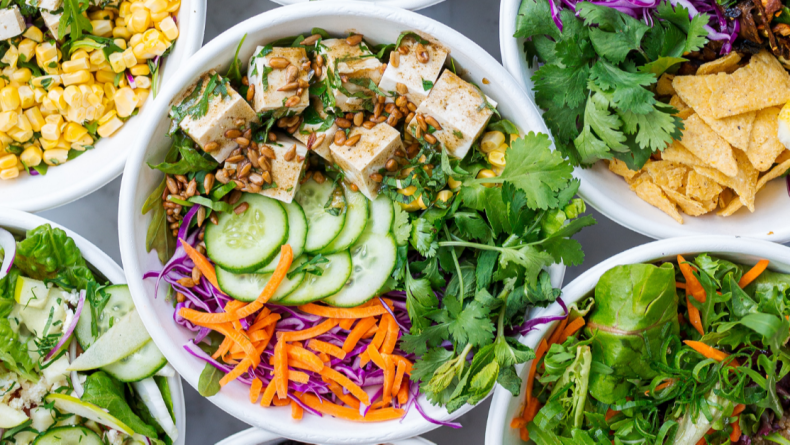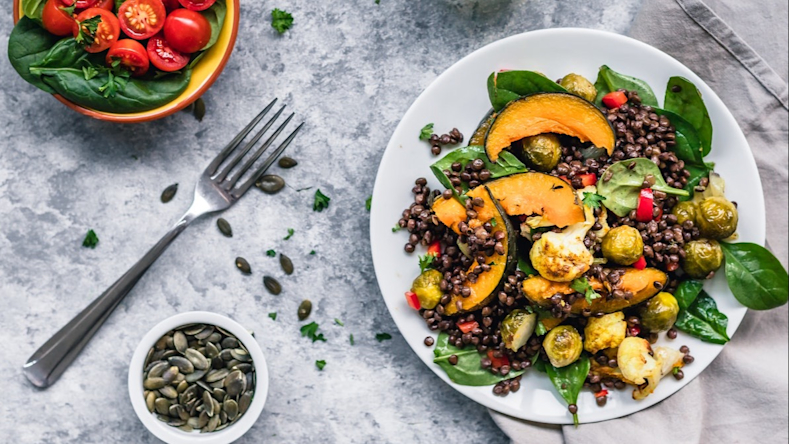Plant-based eating for cycling performance: does it work?
With health experts praising the health benefits of plant-based eating, more elite athletes are turning to plants for long-term health benefits and athletic advantages (such as leaner body composition, improved tissue oxygenation, and reduced oxidative stress) to boost cycling performance.

For years, doctors and dietitians alike have touted the benefits of eating more plants and less meat. And it seems people are listening. A 2020 survey published by the International Food Information Council notes that 28% of consumers are eating more protein from plant sources, 24% are consuming more plant-based dairy, and 17% are eating more plant-based meat alternatives [1]. What’s more, dieters are huge drivers of those numbers. Of those following a specific diet or who identify with a specific eating pattern, 41% say they increased consumption of protein from plant sources (vs. 18% of those not following a diet) and 28% say they eat more plant-based meat alternatives (vs. just 9%) [1].
Plant-based diets have gone mainstream — largely because healthcare practitioners and patients now see plants as the key to a long, healthy life. Plant-based diets have been associated with lowering overall and ischemic heart disease mortality, supporting sustainable weight management, reducing medication needs, lowering the risk and severity for most chronic diseases and conditions, and even possibly reversing advanced heart disease and type 2 diabetes [2].
More and more elite athletes — including Olympic silver medalist Dotsie Bausch Adam Hansen
Before we dive into plant-based eating for sports performance, let’s first take a look at what a plant-based diet is and some of the pros and cons of eating more plants and less meat.
What is plant-based eating?
Plant-based eating is a dietary approach founded on eating foods sourced primarily from plants including fruits, vegetables, nuts, seeds, plant-sourced oils, whole grains, legumes and beans. With a plant-based diet, emphasis is put on food quality and wholeness, and refined and highly-processed foods are typically avoided. However, following a plant-based diet doesn’t always have to mean saying no to meat, eggs, or dairy products. It simply means you choose to eat more foods from plant sources.

Types of plant-based diets
Unlike the keto diet, which has pretty strict food and nutrient requirements, there are several different variations of a plant-based diet. If you identify as eating plant-based, you may fall into one of these categories:
Flexitarian (aka semi-vegetarian): Includes eggs and dairy with occasional meat, poultry, fish, and/or seafood
Pescatarian: Includes eggs, dairy, fish, and seafood; no meat or poultry
Vegetarian (aka lacto-ovo vegetarian): Includes eggs and dairy; no meat, poultry, fish or seafood
Vegan: Plant-based foods only; no dairy, eggs, meat, poultry, fish or seafood; often also avoids leather and other products made with animal-derived ingredients
Raw vegan: Only uncooked plant-based foods; no dairy, eggs, meat, poultry, fish or seafood; typically avoids leather and other products made with animal-derived ingredients

Pros & cons of eating a plant-based diet
Like any diet, plant-based eating has its upsides and downsides. Here are the pros and cons of going plant-based:
Pros of eating plant-based
The potential health benefits are huge.
Adopting a whole-foods, plant-based diet is not only good for achieving a healthy weight, it can also lower your risk and reduce the severity of numerous chronic diseases including heart disease, cancer, and diabetes [2]. Plant-based diets have also been shown to reduce medication needs, help lower blood pressure and cholesterol, and improve blood sugar control [2]. A growing body of evidence suggests vegan and vegetarian diets may help reverse advanced coronary artery disease and type 2 diabetes [2].
The reason for these health benefits is two-fold. First, the phytochemicals and fiber found in plants have numerous intrinsic benefits — from promoting gut and heart health and improving immunity, to reducing inflammation and cancer activity and more. Plants are the only sources of these health-promoting nutrients — they are completely absent in animals.
Second, a plant-based diet simply crowds out the unhealthy components of animal-rich diets, including dietary cholesterol, saturated fats, antibiotics, carcinogenic compounds created during high heat cooking, and more.
It’s easier to adopt and stick with than other diets.
Another positive of the plant-based diet? It’s pretty easy to adopt.
Think of the plant-based diet as a spectrum, with flexitarians on one end and raw vegans on the other. There’s a lot of flexibility and freedom with this approach to eating, which is likely why many find plant-based eating to be one of the easiest diets to stick with. Sure, you can go all-in, but there’s no need to quit meat (or eggs or dairy, for that matter) all at once. Many people start their plant-based journey with just one meatless meal a day and gradually find themselves choosing more plants than meat over time.
Other appealing aspects of a plant-based diet? There are many more foods you can eat on this diet compared to ones that should be avoided. It’s also relatively easy to adhere to this diet thanks to the abundance of goods such as canned beans, quick-cooking tofu, plant-based protein powders, and the many meat alternatives on supermarket shelves these days.

Plant-based is easier on the environment.
Adopting sustainable eating habits, like a whole-food, plant-based diet, can help reduce your environmental footprint (such as greenhouse gas emissions, water consumption, and land used for factory farming) while also greatly reducing the pollution caused by food processing, manufacturing, and packaging.
A systematic review of 63 studies showed diets containing the least amount of animal-based foods (such as vegan, vegetarian, and pescatarian diets) produced the largest environmental benefits. According to the study, shifting Western diet patterns to more sustainable, plant-based eating habits could reduce greenhouse gas emissions and land use by 70% and water use by 50% [3].

Cons of eating plant-based
Plant-based requires some planning and prep.
Like any diet changes that minimize prepared and processed foods, a plant-based diet will likely require a bit more planning and prep. Whether it’s getting in the habit of meal planning, spending a few hours a week on food prep, or making an extra stop for your favorite veggie burgers, it won’t seem quite as convenient as grabbing something to go. At least, at first. The good news is, there’s plenty of room for take-out and convenience foods in a plant-based diet. Whether it’s frozen brown rice, pre-chopped veggies, or takeout pad thai with tofu, there are so many delicious ways to make this diet work.
It can take some getting used to.
Digestively speaking, that is. We all know that increasing intake of fiber-rich plants is good for GI function and can even reduce bloating and gas, but getting there can take time. If your usual diet is relatively low in fiber and higher in refined grains, carbohydrates, and sugar, consider increasing your plant consumption gradually to minimize excessive toots, burps, and bloating early on.
You may fall short on some nutrients.
Nutrient deficiency is a primary concern for many people on a plant-based diet, however, it’s important to know that, with the exception of vitamin B12 and possibly vitamin D, all nutrients can be found in plants. Based on this and the substantial research to support their nutritional adequacy, plant-based diets are appropriate for individuals during all stages of the life cycle, including pregnancy, lactation, infancy, childhood, and adolescence, and for athletes [2].
That being said, there are some important nutrients you might fall short on, particularly if you’re a competitive athlete and/or lean more towards the vegan end of the spectrum. The big ones are Vitamin B12, Vitamin D, iron, and calcium.
Vitamin B12 is the only nutrient not directly available from plants. It’s typically found in meat, organs, eggs, and dairy, so if these foods are not a part of your regular diet, consider a supplement, which is typically taken orally, 1000µg 2-3 times per week .
Vitamin D is commonly added to milk and yogurt but otherwise is not widely available from foods. Although it is synthesized in the skin upon exposure to sunlight, most of us do not get adequate sun exposure to produce enough of it. A simple blood test can let you know where your vitamin D levels fall and whether you might benefit from a supplement.
Iron comes in two forms, heme and non-heme. Heme iron is found in meat and animal foods and is more easily absorbed than non-heme iron, the type found in plants. Non-heme iron is also more susceptible to compounds that inhibit its absorption — like phytates, tannic acids from tea, fiber, dairy-derived calcium, and certain spices. In addition to these challenges, athletes, especially females, have elevated iron needs; thus vegan and vegetarian athletes are more likely to fall low on iron intake/absorption and require supplementation.
Calcium: Research shows vegans and vegetarians are at double the risk for bone fractures [7]. Because calcium is so important for bone health and less abundant in plants than animal-based foods like dairy, plant-based eaters should be mindful they’re getting enough. Calcium-rich plants include kale, turnip greens, and bok choy, as well as calcium-fortified tofu, almonds, tahini and figs. Whether consumed through foods or supplements, calcium, in the presence of vitamin D and K2, may also help mobilize calcium to bones and thus decrease risk of fracture down the road.
Other micronutrients vegans and vegetarians tend to be at greater risk for deficiency are omega-3 (specifically EPA & DHA), iodine (for thyroid health), selenium (an antioxidant that protects against cellular damage and thyroid hormone regulation), and zinc (for immune function and healing), all of which can be obtained via oral supplementation.
Plant-based eating and sports performance
Do plant-based diets hurt or help performance?
Vegan and vegetarian diets have been heavily studied for their impact on overall health, but are they fit for athletes? Whether you’re a recreational rider or an elite cyclist, the answer is yes. Research shows well-planned and implemented plant-based diets are compatible with high-performance and competitive sports [4].
I know what you’re wondering — vegans too? Yep, vegans too. A smaller study that tracked 76 recreational runners for six months found no differences in exercise capacity between vegan, lacto-ovo-vegetarian, and omnivorous participants [5].
These results suggest plant-based diets of all types can be suitable for ambitious recreational endurance athletes, but what about competitive athletes?
Ask elite cyclists, Dotsie Bausch and Adam Hansen, amongst many other top athletes, who have competed at Olympic levels and achieved peak performance while following a vegan diet.
Not only are plant-based endurance athletes able to meet nutrient needs and maintain exercise capacity, a plant-based diet may also come with some other performance perks.
Potential performance advantages of plant-based diets
Apart from being good for overall health and easier on the environment, plant-based diets may offer athletes some additional performance advantages that are worth highlighting. These include [6]:
Leaner body composition: Plant-based diets have consistently been shown to reduce body fat, leading to a leaner body composition.
Favorable glycogen storage: Plants are generally high in carbohydrate and thus promote and support glycogen storage — the muscle’s preferred energy reserves during exercise.
Improved tissue oxygenation: Plant-based diets reduce blood viscosity and improve arterial flexibility, and thus might improve vascular flow and tissue oxygenation.
Reduced oxidative stress & inflammation: Whole food, plant-based diets are typically rich in antioxidants, and low in pro-inflammatory fats, sugars, and refined carbohydrates. Together, this combination can reduce oxidative stress and decrease inflammation that can hinder performance and impair recovery.
With a strategic sports nutrition approach and appropriate supplementation, plant-based diets of all kinds can meet the unique dietary and performance needs of most athletes, elite or recreational — and may even offer a performance edge.

Tips for plant-based cyclists
If you’re considering going plant-based, here are some tips for a smooth transition both on and off the bike:
Fill up on quality, whole foods. A plant-based diet can have significant health benefits, and maybe even give you a performance boost, but it has to be healthy. Fill up on nutrient-dense whole foods like fresh fruits and vegetables, whole grains, nuts, seeds, plant-based oils, and plant-based protein like legumes, beans, nuts and soybeans. Limit refined and processed foods as much as possible.
Eat enough energy. When you replace calorically dense foods with foods that have more volume and fewer calories, you may feel like you’re eating the same amount but that may not be the case. To minimize unwanted weight loss and keep your performance up, your best, make sure you’re taking in an adequate amount of energy. Adding healthy fats and complex carbs to veggie-heavy meals will help.
Keep eating like an athlete. In order to perform like an athlete, you’ve got to eat (and fuel) like one. The foods you eat may change a bit, but the macronutrient composition of the foods you eat pre- and post-exercise should continue to support exercise performance and recovery.
Consider supplements. Even the most meticulously planned diets, vegan or omnivore, can fall short on certain nutrients. Whether it’s a twice weekly dose of B12, a daily Vitamin D or a morning multivitamin, supplements can help bridge the gaps and ensure you’re meeting your nutritional needs. Before you do, chat with a dietitian or doctor to make sure you’re taking the right supplements in the right amounts.
Summary
Plant-based eating is a dietary approach that involves eating primarily (but not necessarily only) plants. Plant-based diets are rich in fruits, vegetables, nuts, seeds, plant-sourced oils, whole grains, legumes and beans, and have heavy emphasis on both food quality and wholeness. There are several different variations of a plant-based diet: flexitarian (or semi-vegetarian), pescatarian, lacto-ovo vegetarian, vegan, and raw vegan. Whichever type appeals most to you, a well-planned and implemented plant-based diet can be suitable for both recreational riders and serious cyclists alike, and may even offer athletes a performance edge.
Disclaimer: The text, images, videos, and other media on this page are provided for informational purposes only and are not intended to treat, diagnose or replace personalized medical care.
Key takeaways
Plant-based eating is a dietary approach founded on eating foods sourced primarily from plants including fruits, vegetables, nuts, seeds, plant-sourced oils, whole grains, legumes and beans.
Plant-based diets are appropriate for individuals during all stages of the life cycle, including pregnancy, lactation, infancy, childhood, and adolescence, and for athletes [2].
Research shows well-planned and implemented plant-based diets are compatible with high-performance and competitive sports [4].
Plant-based diets may offer athletes some additional performance advantages such as a leaner body composition, improved tissue oxygenation, and reduced oxidative stress.
The macronutrient composition of the plant-based foods you eat pre- and post-exercise should continue to support exercise performance and recovery.
References
International Food Information Council. (2020). 2020 Food & Health Survey.
https://foodinsight.org/wp-content/uploads/2020/06/IFIC-Food-
Hever J. (2016). Plant-Based Diets: A Physician's Guide. The Permanente journal, 20(3), 15–082.
https://doi.org/10.7812/TPP/15-082
Aleksandrowicz, L., Green, R., Joy, E. J., Smith, P., & Haines, A. (2016). The Impacts of Dietary Change on Greenhouse Gas Emissions, Land Use, Water Use, and Health: A Systematic Review. PloS one, 11(11), e0165797.
https://doi.org/10.1371/journal.pone.0165797
Katharina C, W. (2020). Vegan Diet in Sports and Exercise – Health Benefits and Advantages to Athletes and Physically Active People: A Narrative Review. International Journal of Sports and Exercise Medicine, 6(3).
https://doi.org/10.23937/2469-5718/1510165
Nebl, J., Haufe, S., Eigendorf, J., Wasserfurth, P., Tegtbur, U., & Hahn, A. (2019). Exercise capacity of vegan, lacto-ovo-vegetarian and omnivorous recreational runners. Journal of the International Society of Sports Nutrition, 16(1), 23.
https://doi.org/10.1186/s12970-019-0289-4
Barnard, N. D., Goldman, D. M., Loomis, J. F., Kahleova, H., Levin, S. M., Neabore, S., & Batts, T. C. (2019). Plant-Based Diets for Cardiovascular Safety and Performance in Endurance Sports. Nutrients, 11(1), 130.
https://doi.org/10.3390/nu11010130
Tong, T. Y. N., Appleby, P. N., Armstrong, M. E. G., Fensom, G. K., Knuppel, A., Papier, K., Perez-Cornago, A., Travis, R. C., & Key, T. J. (2020). Vegetarian and vegan diets and risks of total and site-specific fractures: results from the prospective EPIC-Oxford study. BMC Medicine, 18(1).
https://doi.org/10.1186/s12916-020-01815-3






